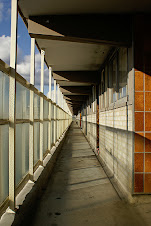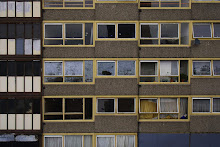Went early to the East Street market this morning, part of which winds through the shadow of the mighty Aylesbury Estate, twenty minutes brisk walk down Walworth into the heart of South-East London. I started going when I lived in the Elephant in the 80’s then went back every time I lived in London after that. I remembered it as winding on forever– a ramshackle English market of cockles and jellied eels, pig’s feet, great mountains of produce, charged with the smell of roasted chestnuts and fresh fish, the hoarse cries of the fruit and veg sellers – all of it exploding beneath the harsh gaze of the massive Aylesbury Estate.
Either the market has diminished or it has expanded in my memory with time, because it isn’t much really – mostly a lot of produce, a lot of cheap clothes that only an English housewife could love. Tools, locks, watch straps. A single seafood stall with fresh crab, cockles, eels but petering out after a half-dozen blocks.
An old guy setting up his breakfast stall – smell of frying sausages, bacon, greases – next to a West Indian woman.
She says, “I hate working next to you!”
He replies: “Don’t go to work then. Go on home.”
She hissed at him and went back to setting up her own stall. When I came back, a big white woman, presumably the man’s wife, was frying up the meat and the black woman was leaning on her wooden display table, putting up those horrible jeans with the sparkly silver inlays.
It wasn’t so much the variety that caught my attention back in the day – aside from the produce, it was stuff you’d find at any Woolworth’s or Army and Navy – but more the atmosphere. The ‘cheap and cheerful’ Cockney thing. The sense of going back to a working class England of housing estates, street markets, smoke-filled pubs with cheap booze; squats, fry-ups on hungover mornings; drunken football hooligans careening down the streets.
How to describe the market?
A big iron sign greets the visitor on Walworth Road (and isn’t Walworth Road itself so evocative? Winding down from that grey sphinx atop the Elephant and Castle shopping centre into the familiar London jumble of cheap diners, old brick buildings, kebab shops, and those old pubs which always seem so charming from the outside with their brick fronts and dark windows, ornate windowframes, the hanging wooden sign over the swinging doors – but are often depressing, even dangerous outposts of drunks, druggies or outright psychopaths inside.
The old ladies with their little shopping carts on wheels, moving inexorably to the market from all sides of the street.
The market winds along a typical street of brick buildings. Stores on the ground floor, flats or store-rooms or offices of some sort up above. The street winds around a bit before joining the edge of the Ayelsbury, which appears from behind the brick in the relatively benign form of concrete gangways and low-rises – two up, tow down – with the little yards or balconies out back, these ugly stucco plates and the metal-framed windows like in the Heygate that swing out all in one like windows in a factory, before the massive bulk of Tuplow House rises up out of nowhere.
Even Tuplow House seems relatively benign, at least at first. The street is almost picturesque, with big trees on either side, and leaves still on the branches and covering the sidewalk and the gutters. The stalls are mostly covered in these ugly coloured plastic material like you find on cheap shopping bags, but the produce – oranges, plums, avacados, carrots and so on – is colourful, particularly with the electric lights shining from the stalls. Even at nine am, when many stalls are still setting up, the vendors are already started broadcasting, “three pound a pound’, ‘top quality merchandise’ into the frigid morning air, while people already queue at the more popular produce stalls.
Stacks of cow’s feet in front of the butchers. The vendors chatting with each other, their regular customers. . . .
I stood at the end of the market and looked up at leaves blowing across the pavement, the edge of the Aylesbury Estate looming up behind the stalls with the grey windows and grey concrete gangways, grey stucco panels . . . and felt at home the way I used to feel at home in London back in the day. Remembering the feeling of being hungover and glad to be out in the fresh air, merging with the thickening crowds of an English market on a weekend morning . . . street . . . gutters full of yellow leaves, the air cold against the face . . . wine- dark stone of some old warehouse on the corner . . . shopping for produce, for stuff to kit out some squat before going to the pub to be part of the early afternoon crowd, the air thick with cigarette smoke, some football game on the TV in the corner.
Sitting or standing by the high windows of a dark Victorian pub, watching the whole street come and go . . . riding some dim memory of being a little kid and visiting my grandparents and feeling at home with the low grey sky, the old wine-dark buildings, a colourful English market winding down a city centre street.






























